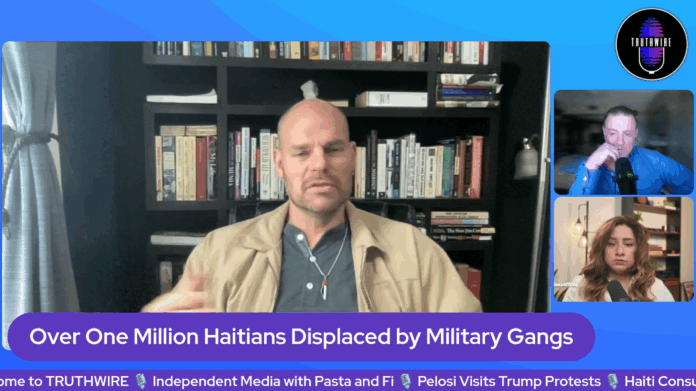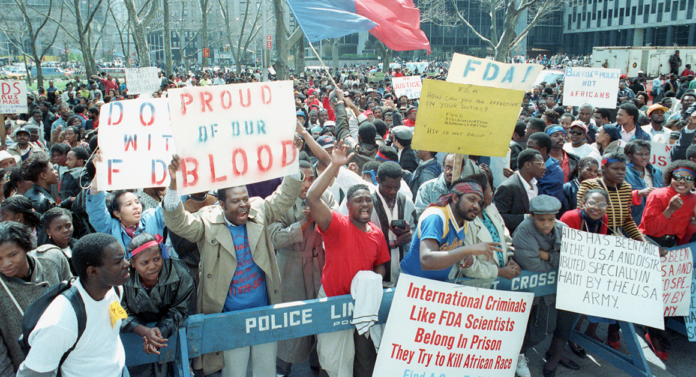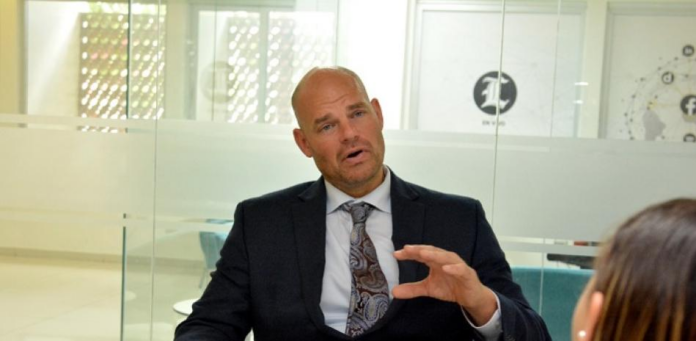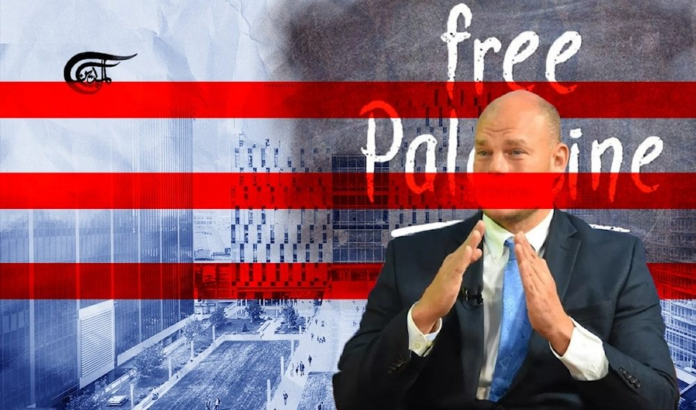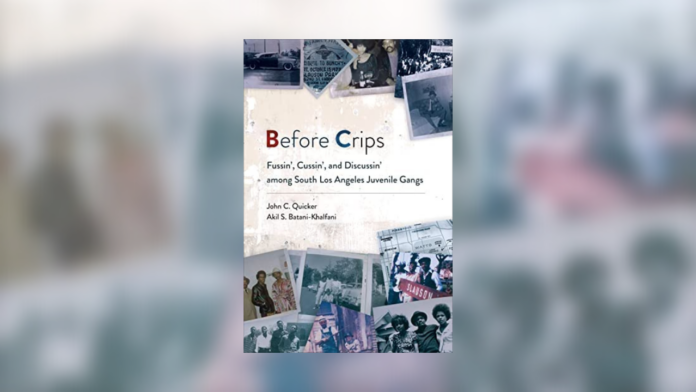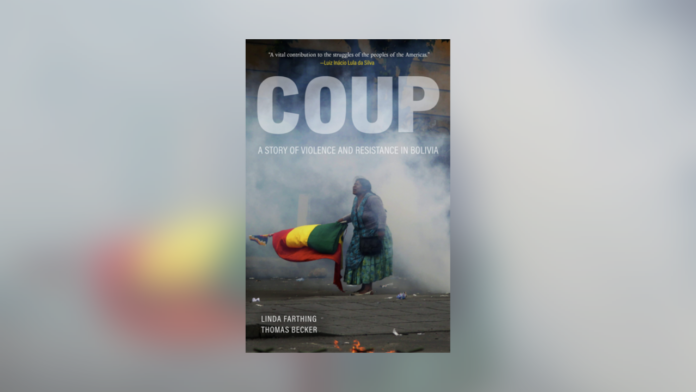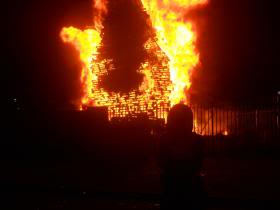Interviewed by Truthwire on April 7, 2025
AIDS, the racist blame game and Haitian resistance
Originally published at Liberation News on April 20, 2015
Haiti’s calendar is emblazoned with glorious dates of popular victory over slavery, racism and foreign occupation. Jan. 1 of this year was the 211th anniversary of the Haitian people’s triumph over the French empire and their colonial allies who attempted to reestablish slavery in Haiti. July of this year will mark the 100th anniversary of the U.S. occupation of Haiti and the steadfast resistance of the Haitian masses led by the Caco leader Charlmagne Peralte. April 20 marked the 25th anniversary of a massive movement that erupted in the Haitian American community in 1990 after the Center for Disease Control published a study blaming Haitians, homosexuals, hemophiliacs and heroin users for the transmission of AIDS in the United States.
The anti-imperialist, national-unity newspaper Haiti Liberte hosted an evening of commemoration in Brooklyn to remember the mass movement that came into the streets 25 years ago to demand that Haitians be removed from this list. A passionate panel of speakers remembered the intensity of the April days and the campaign to unite everyone against the prevailing racism at the time which equated Haitians with AIDS. According to the research of medical anthropologist Dr. Paul Farmer and others, AIDS was introduced from the U.S. into Haiti, but this was never convenient for the mainstream news long-accustomed to unscientific claims which scapegoated African and African-descended peoples for the spread of disease. [1]
Half a million Haitians and their supporters came into the streets on April 20, 1990, marching through their Flatbush neighborhoods in Brooklyn to City Hall making the Brooklyn Bridge shake as it had never shook before. Due to the massive mobilization, the CDC was forced to retract their racist claim. Racism was turned back by the power and unity of the people.
Community leader and journalist Berthony Dupont reminded the crowd: “We are at war. Haiti is at war. They have never stopped waging war against us. They cannot forgive us for overthrowing their rule and demanding our freedom.” He drew a parallel to the introduction of cholera into Haiti by UN troops who today illegally occupy Haiti. The outbreak of cholera has thus far left over 4,000 Haitians dead and the UN has yet to recognize its role in polluting the Haitian water supply and spreading this disease.
Haitian women leaders who were in high school at the time remembered the intense anti-Haitian sentiment that they confronted on a daily basis. One Haitian nurse exclaimed: “They made us ashamed to be Haitian. They said HBO stood for Haitian Body Odor. Haiti was only mentioned in association with coups, violence, hunger and disease. We had to learn to love ourselves. We had to stand up. This mobilization was a key part of our learning to love ourselves and be proud of our identity when we were attacked from all angles.” Waving her fist defiantly, she concluded, “Again we had to teach our detractors: You don’t mess with Haitians!”
April 20 and all of Haiti’s history reiterates the timeless adage that has rung true from Belfast to Port-au-Prince to Ho Chi Minh City: “Repression breeds resistance. Resistance brings freedom.” The Party for Socialism and Liberation salutes the Haitian people for all that they have sacrificed and won for oppressed people everywhere and pledges to stand strong against our common enemy here in the belly of the beast!
In Occupied Port-au-Prince Over 1 Million Haitians Have Been Displaced by Paramilitary Gangs
Originally published at CounterPunch on March 26, 2025
As our rights are under attack by an arrogant clique of billionaires at home, the global beacon of freedom, Haiti, confronts one of the toughest moments in its centuries-long liberation struggle.
For over four years now, burgeoning paramilitary gangs have waged a war on the 2.5 million people of Port-au-Prince. Last year, the disparate paramilitaries confederated into the Viv Ansanm gang under the leadership of former police officer turned warlord, Jimmy “Barbecue” Cherizier. In front of our eyes, the robust capital city of the world-famous carnival, of bustling commerce and proud traditions has been reduced to a city of refugees, shelters and isolated, hold-out communities resisting with everything they have. There are still neighborhoods like Kanape Vè and Akaye where the residents are organized into Brigad Vijilans (Neighborhood Self-Defense Brigades) to fight against the rule of death squads composed of child soldiers and other lumpen cannon fodder. David readies his slingshot against a Goliath, armed to the teeth with an avalanche of U.S. weapons which rendezvous with South American cocaine in this most permeable, punctured and penetrated country of the Caribbean.
The War of Predation
The first question outsiders ask is “Why?” Why are the Viv Ansanm paramilitaries waging war on the civilian population, displacing now more than an estimated 1,000,000 Haitians, or half the capital city?
It is important to highlight that August 22, 2018 represented the birth of the PetroCaribe movement to recover billions of dollars in Venezuelan oil embezzled by the corrupt colonial state. The sight of millions of Haitians conscious, united and mobilised forced the U.S.-sponsored aristocracy to pacify the millions of rebels. They partially built and set in motion a modern-day Frakenstein, their very own tonton makouts. The masses say the gangs are worse because “the criminal police and military wore uniforms and could be identified.”
The “gangs,” as the mainstream media refers to them, are the shock troops of the Haitian bourgeoisie and foreign capital. Researchers Mamyrah Dougé-Prosper, Ernst Jean-Pierre, Georges Eddy Lucien and Sabine Lamour outline the state and gang “predation sites.” Like early police forces in the U.S. and the Duvalier’s private security force, the Tonton Makouts, Viv Ansanm are mercenaries for hire.
“Customs is one site of predation, affording the capacity to import guns, rotted carcinogenic foods, and other expired products that kill. But the bourgeoisie monopolize all industries. The Gilbert Bigio Group, for example, controls construction (iron and wood imports).”
According to these experts and the Haitian masses, the gangs have a definitive agenda. They only hunt down, corral up and occupy poor communities. The highest summits of the elites in Petionville like Pelegren, Morne Calvaire and areas of Laboul have remained untouched by “the terrorists,” or tewowis as the communities say.
Furthermore, the scholars assert, the gangs “destroyed the Superior Court of Accounts and Administrative Disputes offices where government spending receipts are archived, including the dossiers concerning the PetroCaribe arrangement with Venezuela.” The Center for Economic and Policy Research reports on the medical catastrophe set in motion by four years of attacks from armed groups: “the situation is especially dire as only one of Port-au-Prince’s three major hospitals, and only 39 of 92 health facilities in the capital metro area, are now open.”
The gangs are now claiming to be openly involved in legal politics as well, appointing public officials in the areas under their domination. As the Haitian people have told me thousands of times since 2021, this is an “organised and well-planned death project.” Isn’t it curious that the gangs’ agenda is the ruling class’s agenda?
The Masters of Haiti
This video by content creator Tideone showcases the extreme wealth in the hills of Petionville that remain untouched by the gangs. The tiny bourgeoisie rules from here, with their breathtaking views, mansions and well-manicured lawns. Drone footage exposes the underground swimming pools, acres of land and elaborate architecture. The paramilitaries stop a few miles short from these private estates because they cannot bite the hand that feeds them. A feudal distance keeps diplomats and oligarchs enclosed and safe with their fancy designer shops, hotels and private doctors. There are elaborate private militarized security guarding the compounds. If the masses were to rise up in arms and penetrate the Haiti of the 0.01 percent, it would be a turkey shoot for the private police forces and paramilitaries to liquidate any threat.
But the terrorists represent no threat to them. Afterall, they are the offspring of the well-guarded elites. Parents and children have their spats but remain loyal to one another.
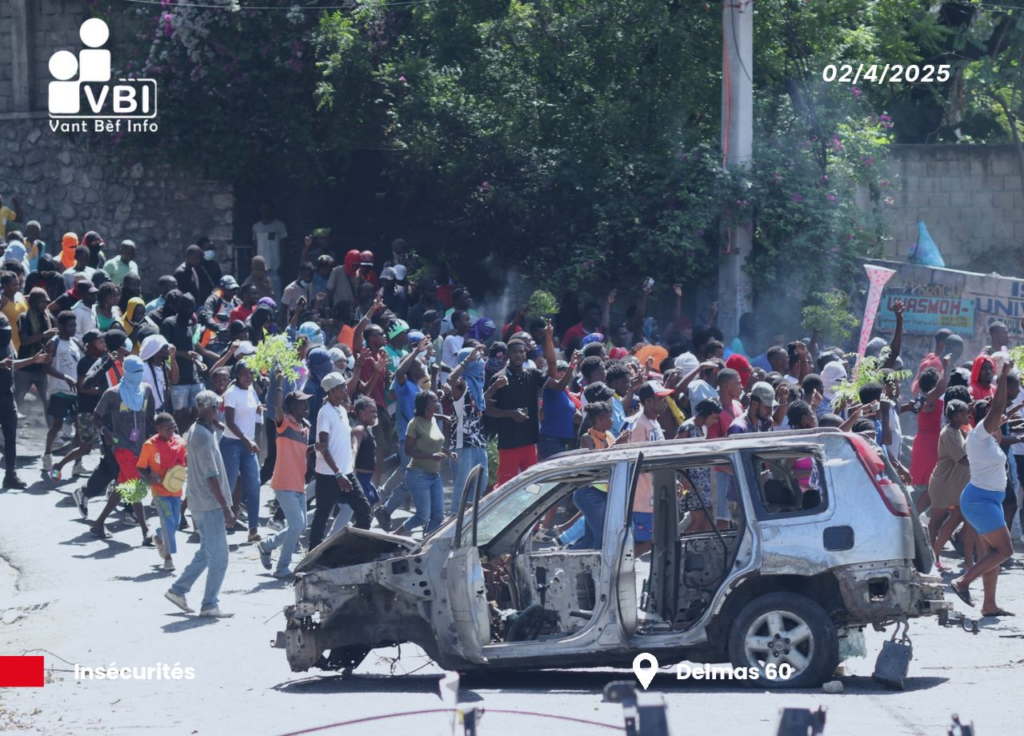
Viv Ansanm Takes Kenscoff
Further north of the oligarchs’ palaces is Kenscoff, a town known in Haiti for its cool breeze, winter hats and lookout points far above downtown Port-au-Prince. Haitians have long visited the serene, picturesque mountain top location to get away from the humidity and ride horses around the enchanted forests.
Kenscoff was the site of the last remaining road that existed outside of the gangs’ control to exit Port-au-Prince to the south and west. On January 28th, Viv Ansanm units attacked the Belot and Godot neighborhoods of Kenscoff. Like the IDF in Gaza and the West Bank, the raiding army shot anybody and anything that moved. Others resisted or fled into the mountains or local public plaza. The Haitian Times reported that this one attack displaced 3,000 people, including 721 children.
All images are from the Haiti Information Project.
A Fractured State
Different elements of the corrupt Haitian National Police (PNH) line up to defend their own interests. Some police officers collaborate with the gangs taking bribes to look the other way, to coordinate arms and drug shipments and to alert Viv Ansanm of pending attacks from the Haitian National Police (PNH). Police chief Frantz Elbe was fired amidst a hail of such accusations. Community leaders remember how guns seized from the gangs magically made their way back into the very same hands they were seized from.
Other elements of the PNH fight the gangs because it is their job and they remember the relatively more stable Haiti of recent years. Other police officers lived in these very neighborhoods and continue to fight alongside the civilian population on the barricades to defend their own families and communities. Some neighborhoods spoke of a necessary, temporary “marriage” with the police to live another day. Before the armed groups, reminiscent of the roving militias that murdered hundreds of thousands and displaced millions in 1990’s Liberia and Sierra Leone.
The PNH has historically been the agent of repression of the social movements. In 2021, they attacked the massive anti-neoliberal uprising and worked alongside the gangs, sniping and executing different popular leaders. In Haiti, all of these state and paramilitary crimes go unsolved. Impunity reigns. The message from all sides is that Resistance is futile. Izo, Lamò San Jou and the other cast of “gangbanging” warlords can move all these drugs and guns without the complicity of the state and the bourgeoisie.
Since 2021 and the advent of “the gangs,” there are now over 1,000,000 displaced Haitians, half of them children. The anti-Haitian, corporate media has conditioned us to think that Haiti is synonymous with war, displacement and tragedy. This relentless war on the population is not normal or common. No. I have known these neighborhoods personally since 1998. These neighborhoods are now gone. One of the main demands of thousands of families in the Palestine of the Caribbean is now: The Right to Return!

The Whitewashing of the Crimes
Viv Ansanm ironically means “to live together.” Smooth-talking, flamboyant gang boss Jimmy Cherezier, the public face of the confederation of the gangs since 2021, now claims Viv Ansamn is a serious political party. While his troops fire Barrett .50 caliber sniper rifles piercing armored vehicles and downing helicopters, Cherizier’s preferred weapon is social media.
As Port-au-Prince continued to burn, on March 6th, Cherezier congratulated his main lieutenants Krisla and Izo for “organizing a beautiful carnival.” These gang chieftains control the Fontamara, Vilaj de Dye, Kafou and Mariyani neighborhoods which give them access to the strategic National Route 2 to travel to Haiti’s South. The battered national highways are a main vein of the international gun and drug trade. Viv Ansanm hosted the carnival, which is historically held throughout Haiti in February, in an attempt to distract from their crimes and project a false sense of stability and happiness in the gang-run city. Local leaders, sociologists and voudou priests have long been trying to educate us through grassroots media projects like ImajINAN (so named after a voudou lwa or god) about the sociology of the armed groups.
The same week that Barbecue again verified why he has earned his nefarious nickname, Colombian President Gustavo Petro pointed out in a cabinet meeting that “much of the cocaine coming from Colombia’s Catatumbo and Guajira region makes its way to the United States through Haiti.” The anti-imperialist president pleaded with the international community to stop the bloodshed.
Here we can see infamous cocaine runner Izo and his gang 5 Segonn (5 Seconds) brag about “being devils,” as they rap about their crimes and the sanguinary war on the population. More and more displaced families are coming under attack a second or third time and are retraumatized, yet Barbecue always claims to be the victim of the attacks. He says here that every accusation against his paramilitary units, turned “political party,” reflects the guilt of others. His role together with his foreign backers is to clean up the image of the anti-social death squads behind the massacres. As absurd as it seems, foreign journalists have played their role in lionizing the butcher of Port-au-Prince. Daily, Haitians ask “How come every time a foreign journalist comes to hang out and take pictures with Barbecue, hundreds of us are murdered?”
The small force of occupying Kenyan, Salvadoran and other international troops protect strategic locations but do not confront the gangs. One is left to ask: Why are they occupying Haiti to begin with? The occupation which, Marco Rubio just breathed fresh life into, may dismantle one gang, “the gangsters in flip flops,” but it will only again solidify the rule of the oligarchs, “the gangsters with ties.” Haitians know a fourth U.S. military occupation in the past century is not the answer, but rather a part of the root cause of how Haiti has been so thoroughly traumatized and decimated.
Standing with Haiti
The author reported from Solino and Nazon last year in a desperate attempt to alert the Western left that these stable working-class bastions of struggle were on the brink of falling. In late October of 2024, gang bosses Kempès and his boss Barbecue took control of these ghettos, burning, looting and murdering their way through family and community life. The thousands of families trapped in these downtown Port-au-Prince slums have now been reduced to begging and pauperism. Lucson Charles, a 22-year-old community leader and foreign language teacher, spoke to the author from Kan Antenor Firmin shelter near Turgo. He described the hunger, squalor and tension at the overcrowded high school turned refugee shelter. He went on to say: “Many families set out in the perilous hellscape in an attempt to beg for food during the day and have to sleep under the rain at night.” The Haiti Information Project reports weekly from the makeshift shelters on the deplorable conditions there.
Lucson, his family and hundreds of thousands of Haitians are now trapped in the murderous grip of Viv Ansanm with no escape possible. The walls of neocolonial humiliation are closing in on this majestic city exploding with an even more majestic, historic people. I am a student of the veteran anti-imperialist leaders from this forgotten capital city in the Western Hemisphere, a city that is the West Bank of the Americas. There is a consensus that this is the most difficult moment in Haiti’s history since the 1804 revolution against French colonialism, Napoleon and tens of thousands of invading troops. What role can progressives and anti-imperialists play to stop the march of death cutting through the heart of Haiti’s capital city and breathe fresh life into one of the epic national liberation struggles of our epoch?
Danny Shaw: Haití ha sido un país explotado, oprimido y mal entendido
Este artículo originalmente fue publicado en Listín Diario el 16 e octubre de 2022.
El analista político estadounidense Danny Shaw ofreció su perspectiva sobre la crisis en la que se encuentra estancado Haití desde hace más de un año y sobre lo susceptible que se encuentra la vecina nación a una intervención militar extranjera.
Durante una entrevista concedida a periodistas de Listín Diario, el catedrático de la Universidad Pública de Nueva York, también definió los retos sociopolíticos de Latinoamérica y analizó la nueva tendencia del resurgimiento de los gobiernos de izquierda en estos países, entre otros puntos.
Partiendo del reciente llamado realizado por el primer ministro haitiano, Ariel Henry, a la comunidad internacional donde pidió apoyo de tropas extranjeras para su país, mismo que puso sobre tapete la posibilidad de que ese territorio sea intervenido, Shaw opinó que la medida sería exagerada.
“He estado viajando a Haití desde 1998, de darse realmente una intervención u ocupación, sería la quinta vez, en cien años, que ese país esté bajo el mando de tropas militares extranjeras”, dijo el analista.
El catedrático agregó que “para entender a Haití hay que retrotraerse a la historia y entender que esa nación nunca ha sido pobre, sino un país explotado, oprimido y mal entendido”.
Shaw aseguró que el pueblo haitiano, desde su perspectiva, no necesita injerencia extranjera. “Ellos solo necesitan una cosa sencilla: que los dejen en paz, porque ellos mismos pueden determinar su futuro”, agregó.
Asimismo, expresó que la comunidad internacional ha tratado anteriormente de “lavarse las manos” con la situación de Haití, pero que realmente sus economías y su capital extranjero están fuertemente vinculados a esta nación y es por esta razón que “nada pasa desapercibido en Haití para ellos”.
Al ser cuestionado sobre si realmente considera que ese país pueda sobreponerse por sí solos a la escasez de combustible, la crisis sanitaria, las bandas criminales y al estallido social, Shaw manifestó que sí y que las movilizaciones son una señal de que el pueblo quiere cambios positivos para su nación.
“Lo que estamos viendo ahora mismo es una continuación de las protestas que comenzaron hace años, el pueblo tiene el derecho de protestar, de movilizarse”, explicó.
Shaw indicó que su planteamiento no sugiere que el camino hacia la recuperación de la paz social en Haití sea fácil. No obstante, dijo estar convencido de que ese país “no necesita muros, sino puentes”.
Latinoamérica y los gobiernos de izquierda
La subida al poder de gobiernos de izquierda en países latinoamericanos como Chile, Colombia, México, El Salvador, Argentina y Perú fue otro de los fenómenos analizados por el experto estadounidense.
Según Shaw, el triunfo de izquierdistas como Gustavo Petro, Gabriel Boric y Andrés Manuel López Obrador en naciones que históricamente han estado bajo el mando de partidos conservadores, se debe a un desgaste del sistema sociopolítico tradicional.
Desde su punto de vista, la globalización nunca llegó a la región, sino que solo experimentó una “gringolización”.
Esto, según explicó, porque no se trataba de un intercambio equilibrado entre estos países y las grandes potencias, sino que siempre ha habido más beneficios y ventajas para el capital japonés, norteamericano, francés o inglés.
“Los pueblos colombianos, peruanos, chilenos, argentinos, mexicanos, se cansaron de tanta explotación, esa coyuntura ha dado espacio a que esos presidentes suban al poder”, dijo.
Shaw expuso que los gobiernos latinos se están evocando en crear su propio sueño, en fortalecer su propio niño. “Ese debería ser el camino, que ningún joven latino tenga que salir de su país para ver cumplir sus sueños”, señaló.
Hizo hincapié en que no siempre los gobiernos de izquierda resultan exitosos para estas naciones y prueba de ello es la situación de crisis en la que se encuentra sumergida Venezuela.
Injerencia de Estados Unidos
“Estamos en una época donde el modelo unilateral de Estados Unidos ha demostrado ser un fracaso y los pueblos se están dando cuenta de eso”, dijo el analista refiriéndose al papel que ha jugado la nación norteamericana a lo largo de los últimos siglos en la realidad sociopolítica de la región.
Sobre esto, Shaw consideró que se puede hablar de que el poder económico de Estados Unidos sobre la región latinoamericana está en declive, no obstante el poder militar se mantiene.
“República Dominicana va a ser la última neocolonia de Estados Unidos, yo creo que este país basa el 50% de su economía en el intercambio comercial con Estados Unidos y dudo que el presidente quiera cambiar eso para asociarse con otra potencia, por ejemplo, China”, añadió.
Sin embargo, acotó que la perspectiva a seguir debería ser que se pueda acabar con esa dependencia histórica, que haya más integración unidad e iniciativas multilaterales.
Movilizaciones
Pasando un balance por los más recientes estallidos y movilizaciones sociales en Latinoamérica, el analista expresó que los mismos son positivos para el fortalecimiento de la democracia.
“Históricamente hemos planteado que las movilizaciones son la antesala de algo mayor, de un cambio real, un pueblo movilizado es un pueblo consciente”, sostuvo el catedrático.
Finalmente, consideró que para cualquier cambio sociopolítico trascendental en la región y en el mundo, los medios de comunicación y últimamente, las redes sociales, tienen un gran peso en las agendas de los países y tienen el poder de visibilizar unos temas sobre otros, por lo que estos deben velar porque no haya censura y se le dé cobertura a todos los hechos.
Estados Unidos. Danny Shaw: Académico a favor de Palestina sufre censura
Este artículo originalmente fue publicado en Resumen Latinoamericano el 11 abril, 2024
Sus colegas y alumnos exigieron la reincorporación del analista al centro con la firma de una declaración en redes sociales.
¿Quién es el profesor Danny Shaw? Que de niño corrió por las calles de Massachusetts, EE.UU. y de joven fue boxeador superpesado en el Madison Square Garden. ¿Quién es? Este hombre que habla de detener el envío de armas a “Israel”. ¿Quién es este protagonista de mítines en Bronx?
Todo eso es y también es un académico que durante 18 años trabajó en el área de Estudios Latinoamericanos y del Caribe en John Jay College, de la Universidad de Nueva York. Un activista por la causa palestina, un pensador, un articulista, recién despedido de la institución por sus opiniones en contra del sionismo.
En diálogo con Al Mayadeen español, reveló que desde octubre recibió miles de amenazas contra su vida y su familia, “por la defensa a la firme autodeterminación de los pueblos”.
Muy pronto, Twitter y otras redes sociales lo condenaron, y donde antes tenía alcance ilimitado, de repente, solo pudo compartir información con unos pocos.
“Queda claro que esto es parte de una censura, pero específicamente aquí (en el país norteamericano), donde se envían miles de millones de dólares en armas y bombas para seguir llevando a cabo el genocidio”, afirmó Shaw.
Sus colegas y alumnos exigieron la reincorporación del analista al centro con la firma de una declaración en redes sociales, que a continuación publicamos: CUNY: Rehire Adjuncts Fired in Retaliation for Pro-Palestine Speech!
El escrito hizo un llamado para poner fin al colonialismo, al apartheid y al terrorismo patrocinado por el Estado, y respaldó a los trabajadores y estudiantes.
Durante el pasado otoño, el centro Hunter College expulsó a la profesora Lisa Hofmann-Kuroda por mostrar solidaridad con un territorio ocupado.
Muchas otras acciones intentan silenciar a los miembros de la comunidad académica que protestan contra la violencia, pero la realidad es innegable. Basta con mirar las imágenes en Palestina para comprender la razón detrás de estas voces.
Estados Unidos. “¡Te cubro las espaldas!”. Reflexiones de los piquetes de los camioneros de Amazon
Este artículo originalmente fue publicado en Resumen Latinoamericano el 27 diciembre, 2024
En un esfuerzo por llevar al gigante capitalista, Amazon, a la mesa de negociaciones para un contrato, siete instalaciones de Amazon se declararon en huelga el jueves 19 de diciembre a las 6 AM. trabajadores de DBK4 en la ciudad de Nueva York; DGT8 en Atlanta; DFX4, DAX5, DAX8 en el sur de California; DCK6 en San Francisco y DIL7 en Skokie, Illinois, iniciaron la huelga. El presidente de los Teamsters (camioneros), Sean O’Brien, se dirigió al propietario de Amazon, Jeff Bezos: “Si su paquete se retrasa durante las vacaciones, puede culpar a la codicia insaciable de Amazon. Le dimos a Amazon una fecha límite clara para sentarse a la mesa y hacer lo correcto para nuestros miembros. Lo ignoraron”. Bezos tiene una fortuna de 238.000 millones de dólares. El trabajador promedio de Amazon se lleva a casa menos de $ 30,000 por año. Amazon generó más de 620.000 millones de dólares en ingresos durante los doce meses que finalizaron el 30 de septiembre de 2024, lo que supone un aumento del 11,93% con respecto al año pasado, pero se niega a reconocer los esfuerzos de sindicalización de los trabajadores. Los trabajadores erigieron un cerdo gigante para simbolizar la codicia antiobrera de Bezos y los multimillonarios.
Si alguna vez hubo una, esta es una lucha de David contra Goliat.
Una instantánea sociológica del proletariado de la ciudad de Nueva York
Los trabajadores son una instantánea del proletariado de la ciudad de Nueva York. Son antillanos, mexicanos, dominicanos, dominicanos americanos, trinitenses, americanos, etc. Muchos llegaron aquí desde uno de los países ocupados por los Estados Unidos, en busca de un sueño. Lo que encontraron fue más lucha de clases.
Esto es Sunnyside, donde Queens se funde con Brooklyn. Todos los trabajadores tienen otros trabajos o actividades secundarias. Esta es la puta ciudad de Nueva York. Sobrevives o no sobrevives. Bajo el capitalismo, a nadie le importas una mierda. Las redes sociales de los trabajadores reflejan esta realidad económica. Desmond canta calipso en clubes los fines de semana. Otros trabajan en seguridad o conducen Uber Eats. Steve se mueve en los clubes a escondidas. Juan Luis es un artista dominicano de hip hop. Inventan movidas cada vez más creativos para llegar a fin de mes. Necesitan mejores salarios. Necesitan un seguro. Necesitan días de baja de enfermedad. Necesitan compensación para trabajadores. Necesitan seguridad laboral. Como dice el inmortal poema de Pedro Pietri “Obituario puertorriqueño “: estos trabajadores han estado luchando toda su vida y nunca han tenido un descanso. Tienen familiares que mantener aquí y otros en sus países de origen. Las remesas son el alma de sus patrias, que aún están en las garras del imperialismo estadounidense.
Hay madres y padres en el frente de piquetes durante el día que traen a sus hijos y familias. Los niños cantan con tanto entusiasmo como sus intrépidos padres. La tripulación nocturna tiene su propia estética. Pasan el coquito navideño (ponche de huevo a base de ron) y comida casera picante mientras el dembow (rap dominicano) y Bruce Springsteen resuenan de fondo. Juan Carlos, Belinda y un equipo se amontonan alrededor de pequeños calefactores que intercambian historias de guerra desde el interior de las instalaciones de Amazon que se elevan sobre nosotros. Comparten música, cantos y café. Después de la puesta del sol, Ramón reparte chocolate caliente. Al ser liberado de la cárcel, Tony, el más querido de los organizadores de los Teamsters, comienza a bailar con una líder obrera, Stacey. Nosotros, corean: “¿Quiénes somos? ¡Camioneros!” y “¿Qué queremos? Un sindicato. ¿Cuándo lo queremos? ¡Ahora!”
Solo el proletariado de Nueva York podía mantener un cierto nivel de entusiasmo caribeño en una noche de Queens a -6 °C. Muchos sueñan despiertos con estar de vuelta en casa en tierras de 30 °C con sus familias y luchan contra la nostalgia, acurrucándose más cerca unos de otros.
Y aquí estábamos, en una noche más en Nueva York, marchando con gente de clase trabajadora de toda tez y acento, luchando por sobrevivir…
Supervivencia hasta la revolución…
En el piquete
El primer día de la huelga, la policía se llevó esposados a los trabajadores que intentaban enganchar a los esquiroles. Un trabajador dominicano grita que los monos azules se están acercando. Intentamos evitar las detenciones, a pesar de la falange de jakes (jerga de Qeens para referirse a los cerdos) y los furgones policiales. Gustavo comienza a cantar, del que se hacen eco cientos de personas: “¡A la mierda Be-zos! ¡que le jodan a Be-zos!”
En el centro de entrega de DBK-4 Amazon ubicado en Maspeth, Queens, los rompehuelgas pasaron, protegidos por la policía. Algunos se cubren la cara porque sienten vergüenza; otros porque nadie les enseñó a creer en sí mismos ni en la clase trabajadora. Algunos nos dijeron que entienden la necesidad de esta huelga, pero que tienen que enviar dinero a El Salvador o Barbados para las fiestas. Esto es realpolitik. Los hechos objetivos son obstinados; Las políticas de identidad son dogmáticas. Esto es Queens, el barrio de “Hazte rico o muere en el intento”. Algunos trabajadores buscan ser la próxima Nicki Minaj o 50 Cent, muchos menos el próximo Joe Hill o Mother Jones. En la jerga marxista, llamamos a esto Falsa Conciencia. Este es el paraíso individualista y consumista, un paraíso antiobrero.
El aliento de los trabajadores es visible mientras condenan el ascenso de Jeff Bezos, Elon Musk y otros oligarcas por encima de nosotros en esta sociedad de castas. Las letras azules fluorescentes A, M, A, Z, O N iluminan la calle. Ponen música para bailar reggae a todo volumen y un DJ local que trabaja como repartidor de Amazon y saca música de todos los rincones de las Américas. El sábado, misteriosamente, hubo una inundación masiva cuando mangueras gigantes arrojaron una avalancha de agua helada en la acera donde los trabajadores estaban haciendo piquetes.
Miles de conductores, maestros y miembros de la comunidad de UPS, incluidos el Partido Comunista Estadounidense, Infrared y Midwestern Marx, han salido en apoyo de todo el país y se han unido a los piquetes. Un miembro de la ACP del estado de Nueva York y organizador laboral expuso la estrategia:
“Como comunistas americanos aspiramos a ser tribunos o defensores del pueblo americano. Hemos apoyado a los trabajadores de cualquier manera material, con alimentos, calentadores, etc. Transmitimos sus voces crudas y sin filtros al público a través de nuestros medios de comunicación. Aprendimos de ellos y obtuvimos una comprensión más profunda de sus preocupaciones y del carácter del proletariado en nuestras respectivas zonas. Para nosotros, como partido joven, fue una victoria. Aspiramos a organizar a los trabajadores estadounidenses, independientemente de sus opiniones políticas, liberales o conservadoras. Las luchas sindicales fueron la escuela de organización que Lenin destacó”.
Preparación para la huelga
Como han enfatizado tanto la prensa burguesa como los Teamsters, esta es “la huelga más grande en la historia de Amazon”.
La primera huelga registrada de Amazon ocurrió en Minnesota en 2018 durante el Prime Day de Amazon. El Awood Center, un grupo de defensa sin fines de lucro en Minnesota para los inmigrantes de África Oriental, organizó la huelga. Las demandas eran de reducción de la carga de trabajo, mejores medidas de seguridad, salarios más altos y una mayor seguridad laboral, un tema recurrente en las huelgas que siguieron. La huelga no afectó a la producción porque no participaron suficientes trabajadores por miedo e indiferencia. Sin embargo, recibió una enorme atención de la prensa burguesa, ya que fue la primera protesta significativa en un sitio de Amazon en los EE. UU.
Desde entonces ha habido pequeñas olas de protesta, con Chris Smalls en el almacén JFK-8 liderando una huelga en marzo de 2020, debido a la propagación de COVID-19 en el almacén. Después de esto, debido a la difusión de información por las redes sociales y la prensa burguesa, los trabajadores en varios otros lugares, a menudo con “la ayuda” de organizaciones sin fines de lucro, lanzaron acciones a pequeña escala. La siguiente acción importante fue en abril de 2021, en las estaciones de entrega DIL3 en Gage Park, Chicago. Los repartidores se marcharon durante el turno. A esto le siguió en diciembre de 2021 una huelga en las estaciones de entrega DIL3 y DLN2 en Cicero, Illinois. Esta última fue la primera huelga en varios sitios en Amazon y ambas fueron organizadas por Amazonians United. A esto le siguió la sindicalización de las instalaciones JFK-8 en Staten Island, con el recién formado sindicato Amazon Labor Union (ALU) en abril de 2022.
Vemos un patrón aquí. Hay histeria por parte de la prensa burguesa sin mayor impacto en la producción. Bernie Sanders y falsos políticos de izquierda como Alexandria Ocasio Cortez le dieron todo su apoyo, adulando tales victorias. Los liberales se especializan en celebrar victorias vacías y simbólicas. Los trabajadores luchan en el espíritu de James Connolly: “Porque nuestras demandas más moderadas son: Solo queremos la tierra…”
El ALU decidió en junio de 2024 afiliarse al sindicato Teamsters. Después de luchas internas, el Sindicato de Trabajadores de Amazon se separó con Chris Smalls como líder y se reorganizó a fines de julio de 2024. Con la asociación de los Teamsters y el conjunto del ALU, los Teamsters avanzaron en su iniciativa de organizar las instalaciones de Amazon. Esto introdujo un gran sindicato con muchos organizadores y fondos en esta lucha y llevó a la sindicalización de miles de trabajadores adicionales. A pesar de los cientos de miles de dólares de los Teamsters invertidos en este esfuerzo organizativo, los resultados han sido deficientes, por decir lo menos. La verdadera prueba de un sindicato es su capacidad para organizar a las masas en una acción colectiva y hasta ahora se han quedado cortos.
La esperanza de los organizadores es que estas acciones despierten a las masas dormidas de trabajadores de Amazon a la acción y generen suficiente impulso para llevar a Amazon a la mesa. En un mitin de clausura antes de las vacaciones de fin de año, los organizadores laborales informaron a los trabajadores de sus derechos Weingarten en caso de que haya represalias contra ellos en el trabajo.
¿Qué son los derechos de Weingarten?
El derecho a un testigo.
Los uniones se crean sobre la base del principio de que todos los trabajadores merecen un trato justo y respeto. Esto incluye asegurarse de que los gerentes no utilicen medidas disciplinarias para castigarlos injustamente a usted y a sus compañeros de trabajo.
Si un supervisor lo lleva a una sala para hablar y cree que puede ser disciplinado, puede sentir que está entre la espada y la pared.
Pero cuando está en una unión, nunca está solo. Siempre tiene el derecho de llamar a los representantes de su unión o lugar de trabajo para que lo respalden en estas situaciones. Estos son sus derechos de Weingarten, que reciben su nombre de un caso judicial histórico con el mismo nombre.
En el caso Weingarten, la Corte Suprema dictaminó que los trabajadores representados por una unión tienen derecho a la representación de la unión en todas las reuniones o conversaciones con los supervisores o gerentes que el trabajador crea razonablemente que podrían conducir a medidas disciplinarias. Estas reuniones o conversaciones incluyen conversaciones en el piso de trabajo, en las áreas de trabajo, en las oficinas, por teléfono e incluso fuera del centro.
¿Por qué debo ejercer mis derechos de Weingarten?
Los delegados y representantes de la unión están capacitados para tratar las medidas disciplinarias, y su función en estos casos es actuar como testigos y como asesores. Una representación de la unión está ahí para:
Exigir a la gerencia que explique por qué se convocó la reunión
Hablar con usted antes y durante la reunión sobre las razones por las que podría ser disciplinado
Escuchar todo lo que se dice y solicitar cualquier aclaración
Detener los cuestionamientos injustos
Tomar los descansos necesarios para una conversación individual
y brindar asesoramiento privado y en tiempo real
El capitalismo tardío: sus desafíos y lecciones
El marxista-leninista Amílcar Cabral siempre decía: “No digas mentiras, no reclames victorias fáciles…:
La producción apenas se ha visto afectada. En DBK4, donde estábamos, la mayoría de los trabajadores cruzaron la línea de piquete, a pesar de la increíble atención mediática que este esfuerzo había recibido de la prensa burguesa. A la medianoche del viernes 21 de diciembre, en las instalaciones de Staten Island, donde los Teamsters representan a 5.500 trabajadores, pocos trabajadores salieron a caminar por la línea de piquete. Había significativamente más izquierdistas que trabajadores, lo que muestra la desconexión en el corazón de esta lucha.
Se trata de una huelga minoritaria contra un gigante capitalista que se esconde detrás de capas de subterfugios legales y trucos de subcontratación. Bezos incluso afirma que los repartidores no son “sus trabajadores”, sino que son empleados de Cornucopia y otros subcontratistas. Los multimillonarios ahora pueden esconderse detrás de las subsidiarias para distanciarse de la explotación de los cientos de miles de trabajadores que los enriquecen.
El problema clave con esta huelga y la organización de trabajadores transitorios como los trabajadores de Amazon y Starbucks, es que los organizadores principales, el personal pagado del sindicato, aún no han escuchado la sabiduría de las masas. Intentan inyectar un espíritu de lucha en la clase obrera y sustituir a los trabajadores. Los trabajadores temporales no quieren trabajar para Amazon por el resto de sus vidas, atrapados en este trabajo aburrido, repetitivo y agotador. Como admite incluso Forbes, uno de los principales portavoces de los multimillonarios, un alto porcentaje de todas las lesiones en el lugar de trabajo en los EE. UU. ocurren en Amazon. La tasa de rotación es de un asombroso 150 por ciento por año. Estas son algunas de las razones por las que hay poca lealtad a la profesión.
Los Teamsters están tratando de llevar a Bezos a la mesa de negociaciones, pero hay una falta de unidad entre la base del movimiento, los 750.000 trabajadores, que son fácilmente reemplazados y entran y salen constantemente del trabajo. En los últimos tres días, The Washington Post de Bezos ha publicado al menos seis artículos diferentes que cubren la huelga desde la perspectiva de los accionistas. Continúan descorchando champán a medida que sus acciones suben y sus propias empresas de medios glorifican una lucha condenada al fracaso. Los analistas laborales explican la lógica de la clase dominante. Apuntalan luchas imposibles de ganar, complementarias a sus objetivos de la continua ocupación del pueblo estadounidense y de los pueblos del mundo.
La prensa burguesa es el arma del enemigo y se utiliza para engañar y desviar a las fuerzas revolucionarias. Twitter, o X, es territorio enemigo diseñado para minar nuestras energías militantes. No podemos confiar en las redes sociales para descubrir nuestros deberes para con el trabajador estadounidense. Debemos profundizar nuestra investigación independiente, utilizando nuestras propias fuerzas, y convertirnos en el factor decisivo que asegure que los trabajadores no solo luchen, sino que ganen.
Nos corresponde a nosotros, como comunistas, determinar las realidades concretas y la correlación de fuerzas dentro de cada lucha obrera particular que surja. No basta con apoyar a los trabajadores en huelga, sino que también hay que considerar por qué es así La gran mayoría no se declaró en huelga, sin simplemente descartarlos como “esquiroles y traidores”. Debemos seguir tendiéndoles la mano y escuchar sus voces.
La ACP está llevando a cabo una investigación más exhaustiva sobre el trabajo en nuestras regiones y a nivel nacional. Tratamos de comprender: ¿Cuál es el carácter del proletariado en nuestras regiones particulares? ¿Cuáles son las industrias más críticas y dónde son los trabajadores más fuertes? ¿Cuáles son las luchas que esconde la prensa burguesa? ¿Qué luchas tienen más probabilidades de ganar y cuáles necesitan más apoyo? ¿Qué luchas promueven los intereses generales del proletariado estadounidense y lo acercan a la toma del poder? ¿Cómo podemos impulsar la inmersión “sensorial” y la participación práctica de todos los cuadros, en particular de los terminales en línea?
La ACP considera que la investigación social y la participación activa de la comunidad son absolutamente esenciales para responder a estas preguntas y como la medida más honesta de quiénes son los líderes emergentes.
¡Te cubro las espaldas!”
Para todos los detractores, que dicen que los Bezos, Musk, Clinton y Trump son
intocables, los proletarios no nos sentimos derrotados.
24 horas antes de la más sagrada de las fiestas familiares, los trabajadores se mantuvieron firmes. Estos cinco días de diciembre nos han enseñado mucho sobre el proletariado estadounidense, sobre nosotros mismos y sobre nuestra relación con la clase obrera. Una y otra vez, aquellos de nosotros en el fragor de la lucha de clases, escuchamos cuánto habían crecido los trabajadores de Amazon como amigos, hermanas y hermanos y, lo que es más importante, como camaradas. Un líder obrero se quitó la calavera de los Teamsters Amazon para prometer su apoyo a cualquiera que necesitara ayuda para seguir adelante. Con este simple gesto, inyectaba optimismo allí donde los multimillonarios insistían en la división, el sectarismo y el pesimismo. Decenas de repartidores y repartidoras comentaron que nunca habían pasado tanto tiempo con sus compañeros de trabajo. Acurrucados alrededor de calefactores, prometieron apoyarse unos a otros para avanzar, decididos a atraer a más de sus compañeros de trabajo a las líneas de piquete. El organizador de los Teamsters, Tony, cerró un mitin final antes de la víspera de Navidad exclamando: “Esto es solo el comienzo. Ninguno de nosotros, como individuos, somos héroes. Juntos todos somos héroes. Somos la chispa. ¡Inspiraremos a decenas de miles de personas a hacer huelga!”
Book Review: ‘Before Crips’ Dismantles Dominant Narrative on Gangs
Originally published at Toward Freedom on November 29, 2022
Before Crips: Fussin’, Cussin’, and Discussin’ Among South Los Angeles Juvenile Gangs by John C. Quicker and Akil S. Batani-Khalfani (Temple University Press: Philadelphia, 2022)
For the past several decades, the media has severely manipulated the question of gangs and their socio-economic origins. John C. Quicker and Akil S. Batani-Khalfani’s new book, Before Crips: Fussin’, Cussin’, and Discussin’ among South Los Angeles Juvenile Gangs, exposes the mainstream stigmas and half-truths surrounding gangs. It also explores the true history of the South Los Angeles street organizations that predated the Crips and the Bloods.
Drawing on research by other progressive scholars and ethnographers, the two authors chart the landscape of street groups and their way of life before the Black Liberation Movement that emerged in the 1960s. They found that the true legacy of the early street groups was one of unity, self-defense and resistance, not one of bullying, crime and violence.
Letting the Real Experts Speak
Quicker, a sociology professor for the past 32 years at California State University, Dominguez Hills, and Batani-Khalfani, or Bird, one of the founders of the Slausons street group, teamed up to write this timely book.
Challenging the dominant definition of “gangs,” the authors prefer to use the term “street organization” or “street group,” because they “most accurately characterize the juvenile assemblies of early South Los Angeles” (page 62). The veterans and founders of early groups, such as the Businessmen, the Slausons, the D’Artagnans and dozens of other street groups, called themselves “neighborhoods, hoods, barrios, clubs, social clubs, brotherhoods and sets” (page 56). Respondents the authors interviewed saw many college fraternities, the police and other dominant societal groups as fitting the conventional definition of a “gang” (page 43). The authors conclude, “A group is a gang when those who control the definitions say it is.” Citing sociologists C. Wright Mills and G. William Domhoff, they write, “Defining right from wrong and good from bad is primarily a prerogative of the power elite or the upper class who accomplish it directly or indirectly through their operatives” (page 43).
Throughout the text, the two authors pull no punches debunking racist and classist sociology that masquerades as “Gang Studies,” permeating the media and the academy. They posit their mission is to allow the “experts’ experts” to speak. Bird, and others who have lived this reality, speak throughout the book and challenge the dominant canon. For example, they expose the control perspective narrative that posits that gang leaders are the most “sociopathic” members. Drawing on German sociologist Max Weber’s theory of “charismatic leadership,” they show how the Slauson leaders were really “heroes” up against “systematic suffering” (page 124).
Beyond Crips builds on the research of sociologist David Brotherton, whose work revealed “a discussion about gangs is never just about gangs. It is about history, morality, politics, responsibility, and how the researchers view the world and the society of which they and the gangs are part” (page 14). They collect their data from “oral histories from living experientialist historians” (page 20). The extensive interviews they conducted tracked the individual, family and community backgrounds of key early South Los Angeles street-group figures, such as Chinaman, Roach, Kumasi, Wild Willie Poo Poo and so many other larger-than-life street sages who paved the way for future generations.
In reflecting on the social forces that brought them together into “bands of brothers,” early street-group members would invoke the phrase, “rather be judged by twelve than carried by six.” In other words, they would rather go to court for defending themselves, facing 12 jury members, than be carried by six coffin bearers to their burial). Some of those social forces included the second great migration from the U.S. South triggered by World War II, “economic racism” (page 25), the “ghettoization” of Watts (page 26), and the need for self-defense against the police and white supremacist gangs that had migrated from the South (page 32).
The authors provide an ethnographic overview that goes beyond the “if it bleeds, it leads” sensationalistic news headlines (page 302). They look at women’s participation in gangs (page 183), the relative lack of drug use beyond alcohol and marijuana (page 269), and the lower crime patterns prior to the 1970s (page 277). The study reviews major hegemonic and counter-hegemonic literature on street groups, establishing no accurate study of “gangs” can arise from outside the communities that gave birth to them.
‘Born in a State of Suspended Animation’
The final chapters look at the leadership of “Mayor of the Ghetto” Alprentice “Bunchy” Carter and the Black Panther Party, to which he belonged. Many Slausons and street group members joined the Panthers. Others would have, too, if it were not for the hand of the U.S. state. To understand the rise of the Crips and Bloods, so vilified by the power structure, one has to understand the FBI’s Counterintelligence Program (COINTELPRO) and the mass repression of the Black Power Movement. In 1969 alone, the FBI and U.S. police departments targeted and executed 28 Black Panther leaders.
The final chapter begins to explain the rise of the Crips and Bloods and explores how what would become “modern gangs” were “unable to embrace the ideology,” as in the Black Panther’s ideology of liberation (page 299). The social vacuum left by deindustrialization and state violence beheaded the leadership of the most oppressed communities. Kumasi, a former street-group leader who is now a community organizer, further explains (page 332):
“The original Crips came out of our neighborhood. They were the children we passed by every day and paid no attention to. But they watched us. We had something to attach ourselves to, to connect with—the great personalities of our parents’ generation—but they didn’t. They were born in a state of suspended animation, totally disconnected, like a planet out of orbit. They were made in America.”
Before Crips takes its place alongside Brotherton’s and liberation theologian Luis Barrios’ The Almighty Latin King and Queen Nation: Street Politics and the Transformation of a New York City Gang, as well as the work of the recently deceased author Mike Davis, ethnographer Dwight Conquergood and other progressive scholars. Like the must-see documentaries, “Bastards of the Party,” “Black and Gold” and “Crips and Bloods: Made in America,” this new book centers the voices of the organic intellectuals who have lived, fought and died in this reality.
Book Review: ‘Coup’ Recounts How the Bolivian People Foiled Another U.S.-Backed Attempt At Recolonization
Originally published at Toward Freedom on April 14, 2022
Coup: A Story of Violence and Resistance in Bolivia, by Linda Farthing and Thomas Becker (Haymarket Books: Chicago, 2021)
A new book, Coup: A Story of Violence and Resistance in Bolivia, provides an in-depth, balanced view of the 2019 coup and the ongoing Bolivian revolutionary process. Journalist Linda Farthing and attorney Thomas Becker’s 306-page book evaluates the balance of class forces that led to the coup, as well as the anti-imperialist forces who were ultimately able to repel it and seize political power again in the plurinational state of 11.4 million.
The Plurinational State of Bolivia Emerges
In 2006, Bolivia embarked upon a new path, with an emphasis on social benefits reminiscent of revolutions past, from the Soviet Union to Nicaragua to Grenada.
The plurinational leadership, representing 36 different Indigenous languages, fought against a legacy of white supremacy, which many experienced as “apartheid without pass laws” (30). (Pass laws were used in South Africa to police Africans, forcing them to carry identification at all times.) In Bolivia, they established the Ministry of Institutional Transparency and Fight Against Corruption to uproot corrupt interests and clientelism sabotaging government attempts at reform (33). Social movements were now part of the people’s government. Part II of the book, titled “Fourteen Years of the MAS,” charts these enormous social gains that made it clear to the world that the decolonization of every facet of society, from the educational system to the media, was possible (71). MAS stands for Movimiento al Socialismo, or Movement Toward Socialism.
At the helm of this long overdue social transformation was coca farmer, trade unionist and veteran of the Cochabamba Water War and Gas Conflict, Juan Evo Morales Ayma. Morales emerged as the inspiring local and international representative of the Aymara, Quechua, Uru, and other Indigenous nationalities and working-class mestizos long marginalized in Bolivian politics and the economy. Every September at the United Nations General Assembly, Morales—as Bolivia’s president—articulated a defense of Pachamama, the Andean Earth Mother, spearheading a trailblazing, international environmental movement from the bottom. At the same time, MAS leadership, particularly Morales, was present in Managua, Havana and Caracas, forging an internationalist, Bolivarian unity project.
It was clear to all anti-imperialist observers that Bolivia and the global hegemon to the north—the United States—were on a collision course. In 2008, MAS leadership ordered U.S. ambassador Philip Goldberg to leave the country after they found out USAID had used its Office of Transition Initiatives to give $4.5 million to the pro-secessionist Santa Cruz departmental government. The Bolivians then expelled the U.S. Drug Enforcement Agency from their country.
Supporters of profound social change inside and outside of Bolivia wondered: How long before imperialism and their local agents seek to decapitate this vital leadership and halt the progressive social changes under way?
‘Black November’
Like all U.S.-backed coups in South America and the world over, this one was based on violence and intimidation.
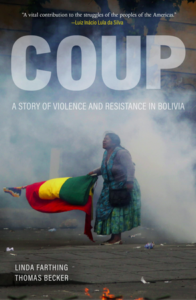
Farthing and Becker document the mobilization of fascist groupings based out of the European enclave of Santa Cruz, as well as police raids targeting MAS leaders and the destruction of the wiphala and other Indigenous symbols. Lighter-skinned European descendants and mestizos screamed “F*ck Pachamama,” blamed the MAS for the corruption that existed in the country, and forced Morales and other leaders to go into hiding and exile (141).
Once in office, Añez and her cabinet picks worked to undo 13 years of social gains. They retired their embassies from progressive countries, kicked out 725 Cuban doctors, and re-established relations with the United States and Israel (166).
In November 2019, 35 people were murdered for standing up to the coup (155).
The class-conscious researchers dedicate chapter 5 to documenting the extreme, racist repression to which millions of Bolivians were subjected. Through interviews with massacre survivors, the authors reconstruct how soldiers shot into crowds that had marched outside of the city of Cochabamba, turning another city called Sacaba into a “war zone” (147). “At the end of the day, Añez’s fourth in office, state forces had killed at least 10 and injured over 120 protesters and bystanders. All casualties were Indigenous, not a single police officer or soldier was harmed” (149).
When Lucho Arce took power as president in 2021, he recognized the blood that was shed to restore MAS to power, “asking for a moment of silence for those killed in Senkata, El Alto; Sacaba, Cochabamba; Montero, Santo Cruz, Betanzo, Potosi, Zona Sur La Paz; Pedregal, La Paz” (194).
Resuming the Path of Revolution
On November 9, Morales returned to his homeland. Millions came out into the streets, converging on Chapare, a MAS base, to see their humble leader, who never stopped standing up to the U.S. empire and their local agents. Admiring families brought him his favorite meal, chuño (freeze-dried potatoes) and charque (dehydrated meat), expressing how Morales “has made us proud to be Indigenous” and “we wouldn’t be here without Evo” (203).
Arce was the economic minister under Morales. He represents the ongoing defense and promotion of the class interests of the poor. Arce’s government presented this month an economic reconstruction program dedicated to building additional housing projects for the underprivileged, infusing $2.6 billion into the economy to satisfy mass consumer demands, opening up lines of credit, placing taxes on personal fortunes above $4.3 million, and increasing subsidies and pension plans (200).
Farthing and Becker present a balanced view of the Bolivian experience anti-imperialists everywhere can learn from. They don’t hesitate to dive into MAS’s challenges, excesses and mistakes. They contextualize the errors within centuries of Spanish colonial bureaucracy and underdevelopment. Potosi historian Camilo Katari also examines this wicked inheritance and how it continues to plague the Bolivian state today. Revolutions, now in the driver’s seat of history, don’t just attract the best of us. Careerists, opportunists, and other neocolonial bitter-enders jostle within local and national bureaucracies to secure their own sinecures and petty interests.
The Bolivarian Camp Pushes Forward
Bolivia occupies a unique space in the U.S. left’s imagination. Sometimes it may seem like they are spared some of the harshest neoliberal critiques. The truth is CNN en español and other corporate outlets continue to function as mouthpieces for the Añez camp and vilify Bolivia’s process. The full slate of corporate media outlets and leftist-liberal outlets go after MAS arguably as hard as they go after Nicaragua, Venezuela and Cuba.
Bolivia, Nicaragua, Cuba and Venezuela—the anchors of the Bolivarian camp—have been spearheading the multi-centered global process. Venezuelan President Nicolas Maduro recently finished high-level meetings with Nicaraguan and South African leadership to continue building unity against the United States’ hegemony. These maroon states—those in which a large percentage of the population is of African descent—represent a permanent threat to the unipolarity U.S. transnationals are hellbent on imposing around the globe.
Coup is an important contribution, lest we forget where we need to stand and fight at this historical moment as neoliberalism and unipolarity are on the wane and a multipolar world surges forward from below.
America’s Worst Dad
Dedicated to Viviana and Vinny:
Somersaulting over translucent horizons
with the levity of the ancestors
& the lightheartedness of our parents
My son Ernesto was nine years old in the summer of 2011. I applied for and received a research grant from the Professional Staff Congress, the union for professors at the largest university system in the country, the City University of New York (CUNY). We traveled to Maui and the Big Island to visit friends and research how the U.S. government and elite agribusiness interests coerced and trafficked Puerto Rican jibaros (peasants) to the Hawaiian islands to toil in sugar cane and pineapple plantations in the early 1900’s. These rich tracts of land were owned exclusively by the oligarchs of the “Big Five,” Castle & Cooke, Alexander & Baldwin, C. Brewer & Co., H. Hackfeld & Co. (later named American Factors) and Theo H. Davies & Co. Our friends in the working-class neighborhoods far away from Honolulu proudly wore t-shirts that read “I am HawaiiaChinaFilaPortRican and proud!” The national slogan spoke to the diverse ancestry of a nation of some 1,000,000 Native Hawaiians who have a mix of “native Hawaiian, Chinese, Filipino, Portuguese and Puerto Rican ancestry.”
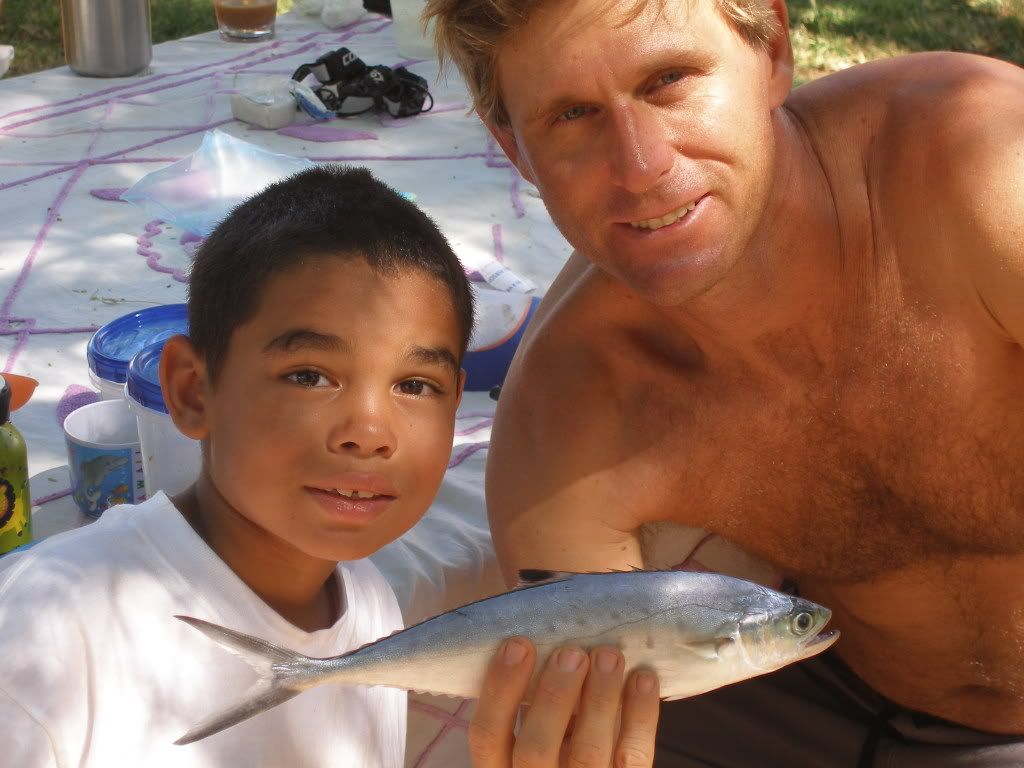
I took Ernesto hiking through the steep rungs of Mauna Loa volcano. He was overwhelmed by the grueling climbs, but he fought through, too proud to complain. In the early evening, I asked him if he wanted to learn how to drive on the top of Mauna Loa. His legs could not reach the break and accelerator. He sat on my lap. I had Biggie Smalls and 112’s 1996 classic “Only You” on repeat as he learned to smooth out the initial herky-jerky movement an untamed car makes. We had fun on our trip. We camped out with native Hawaiian communities who had been pushed out of their family and ancestral lands by one of the highest real estate markets in the country. Our favorite memory was a specific utterance of Hawaiian Creole that the native islanders spoke. One displaced worker, Uncle Keanu, was squatting on the beach playing with his dog and telling us stories of Waianae and Makaha resistance against police evictions. We stayed in his makeshift camp, making friends who I keep in touch with until today. Uncle Keanu’s signature phrase was “Fuck a booby right here!” as he called his dog back to him. He kept his rifle close in case any Hawaii Five-o’s dared to return to evict him and his family.
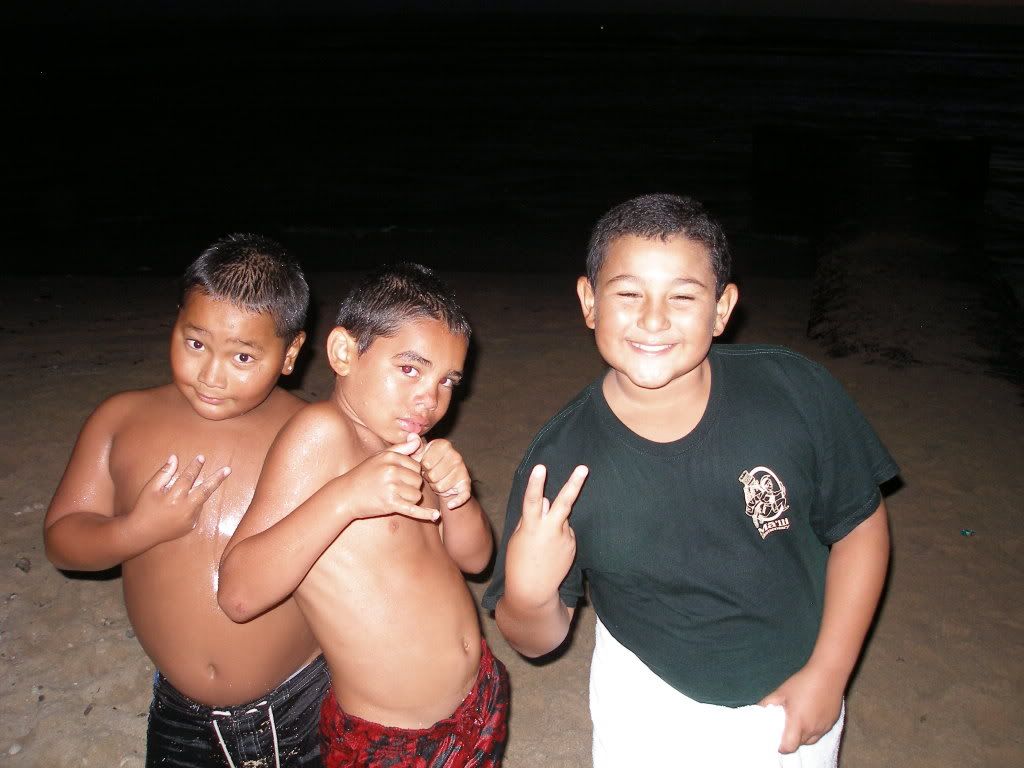
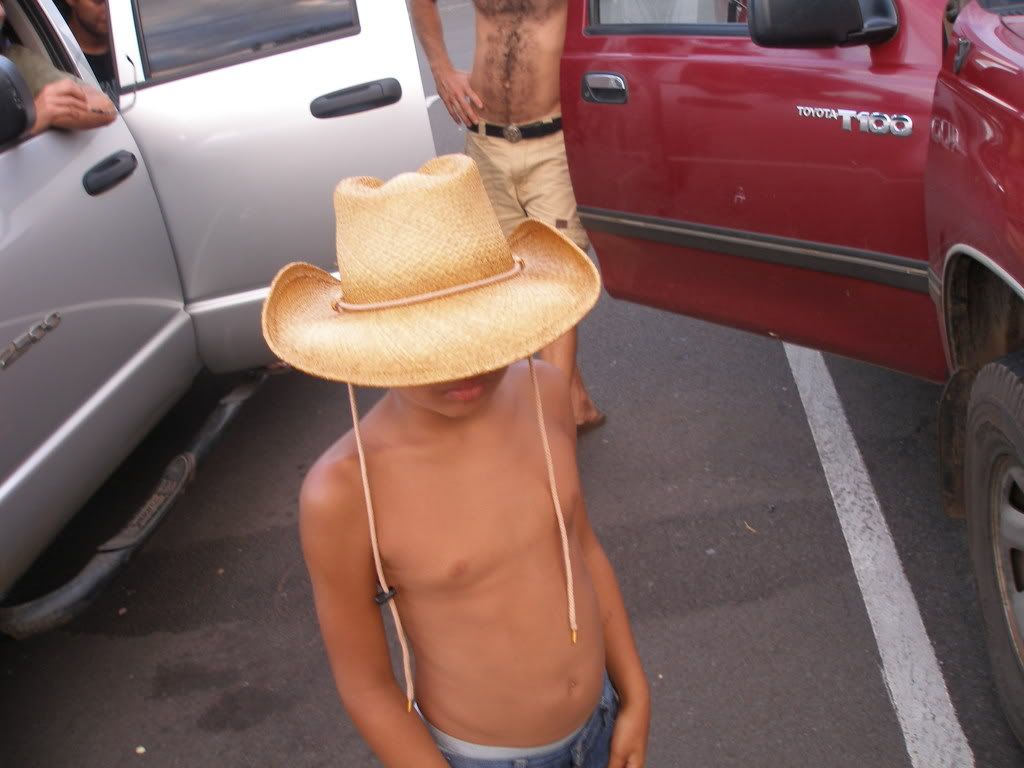
The following summer of 2012, I took my son to hang out and box with the Inmaculada Boxing Club in the 6 counties in the north of Ireland, divorced from the 26-county Republic. It was marching season in Occupied Ireland.

By night, the bonfires roared across West Belfast. Many a colonial Union Jack met its incendiary fate hung above 40 feet of wooden crates alongside other occupying enemy flags. This was Ireland Ireland. Green. Bold. Nationalist. The local Catholic youngsters kept the police entertained and busy all night.
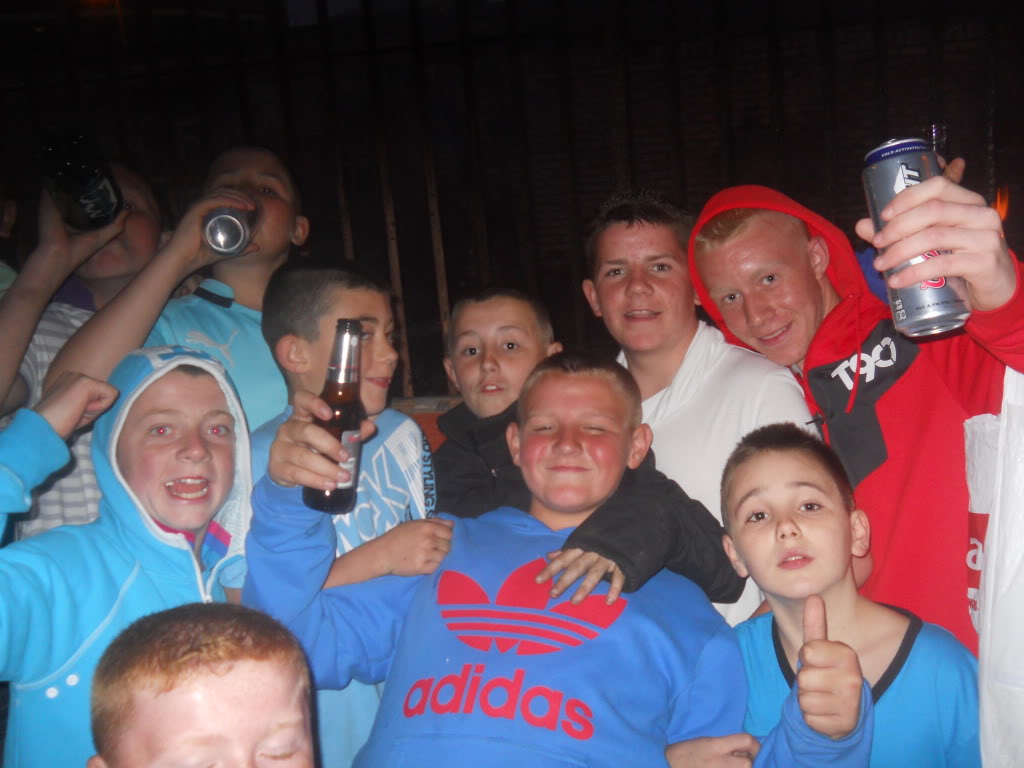
When the paddy wagons stopped at the intersection of West Falls Road, the local ruffian‘s pounded two by fours over the peelers’ (Belfast slang for police or pigs) windshields. The 12-year-old urban guerrillas lobbed bricks, stones and molotov cocktails at the police who didn’t dare get too close. Former IRA commanders dressed as uncles took a swig of Guinness applauding the lads with hands that were not guaranteed to have five fingers. These were anti-colonial snipers and anti-humiliation bombers’ hands.

Ernesto was right there with his peers and sprouting comrades. He had turned 10 years old the month before. One social worker masquerading as a reveler whispered to the local gossip girls that the other side of the pond brought “America’s worst dad” back to Ol’ Ireland.

The Hunts Point section of the Bronx has long been known for its infamous alleyways and boulevards with the freshest drugs and baddest prostitutes. Hunts Point always had a reputation that preceded itself. A fatal overdose brought the faithful-to-death forgotten herds scampering for the most sought after of fixes. Boyfriends met their girlfriends and husbands met their wives outside the six train or at the Bx 6 bus stop because it was too dangerous for the women to walk home alone at any time of the day. Addicts screamed at dealers, showing off their punctured and penetrated veins as proof that they were not undercover cops and were worthy of their heroin and fentanyl. I taught my son how to drive in Hunts Point. I made a video for Facebook of “the youngest Dominican taxi driver in the history of the Bronx.” Family members felt I was being reckless with my son, raising their objections under my post and in real life. Someone called Children Protection Services on me. As I told the CPS agents who arrived at my home the next night, “driving is a skill.” By the time Ernesto could reach the steering wheel and brakes, he drove like a man. I have observed his nerves of steel under extreme duress. I have also witnessed him fall 100 times. He has stood right back up every time.
Lenore Skenazy was “America’s worst mom.” In 2008, she granted her nine-year-old son Izzy permission to ride the New York City subway by himself. She dropped him off in one part of Brooklyn, armed him with a map, a paper with their address written (just in case), a $20 dollar bill and quarters in case he needed to make a phone call. He was home within 45 minutes. The story of the atypical mother became big news. First amendment lawyer Greg Lukianoff and New York University social psychologist Jonathan Haidt tell the story of Skenazy in The Coddling of the American Mind, How Good Intentions and Bad Ideas Are Setting Up a Generation for Failure: “two days later [Lenore] was on the Today Show, and then MSNBC, Fox News, and NPR. Message boards were flooded with posts,” as she recounted, “mostly condemning our decision, others applauding it.” Soon Skenazy was decried as “America’s worst mom.”

I lectured my college students today in this my 20th year of teaching as only a 47-year-old grouchy professor could. This was no classroom lecture with a powerpoint. I was lecturing them. I broke everyone of Paulo Freire’s rules from Pedagogy of the Oppressed as I scolded them in a way only their parent’s generation, Generation X, aka Generation Grumpy, could:
“You all are of the fragile generation; the screen generation; the iPhone generation; the terminally-online generation; the depressed generation; the anxious generation; the asocial generation; the fearful, punk generation; the call-out, cancel culture generation; the filtered, plastic-surgery Instagram generation; the paranoid parenting generation; the Culture Wars generation; the doxed generation; the social media generation; the addicted-to-porn and addicted to everything generation; the microaggression generation; the catastrophizing generation; the gender identity generation; the safetyism generation; the trigger-warning generation; and the identity politics generation. But does your generation know inner-peace?”
One intrepid student did not blink: “Professor: do you like anything about us?”
It was an honest question.
I collected my thoughts.
I did not see this type of cowardice growing up, though I was surrounded by no lack of cowardice. I appreciate everything you teach me every day. It is humbling. At times, the spiritual disconnect could not be greater.
As Haidt’s research shows in The Anxious Generation: How the Great Rewiring of Childhood Is Causing an Epidemic of Mental Illness, for the first time in millions of years, there is a generation of mammals who did not grow up playing with one another. Nor do these un-curious mammals have a relationship with nature. This is the first technology-based childhood in the mammal timeline. Our sons and daughters are the guinea pigs of the billionaire CEOs of TikTok, Call of Duty and Pornhub. Haidt and Lukianoff sum up their conclusions:
But efforts to protect kids from risk by preventing them from gaining experience–such as walking to school, climbing a tree, or using scissors–are different. Such protections come with cost, as kids miss out on opportunities to learn skills, independence, and risk assessment. (Keeping them indoors also raises their risk of obesity.) Skenazy puts the case succinctly: ‘the problem with this ‘everything is dangerous’ outlook is that overprotectiveness is a danger in and of itself.’
The establishment’s treatment of my new favorite mom, Lenore Skenazy, is a reminder that we will never be lauded and will always be judged when we teach our children to think independently, because it is only then that they are a threat to the order of things.
In contrast to many of his peers, my son is a chameleon. Drop him off in Beverly Hills. He will make 10 friends. Drop him off in South Central. The result will be the same. “Fear is a thief” so Ernesto Dessalines pickpocketed fear.
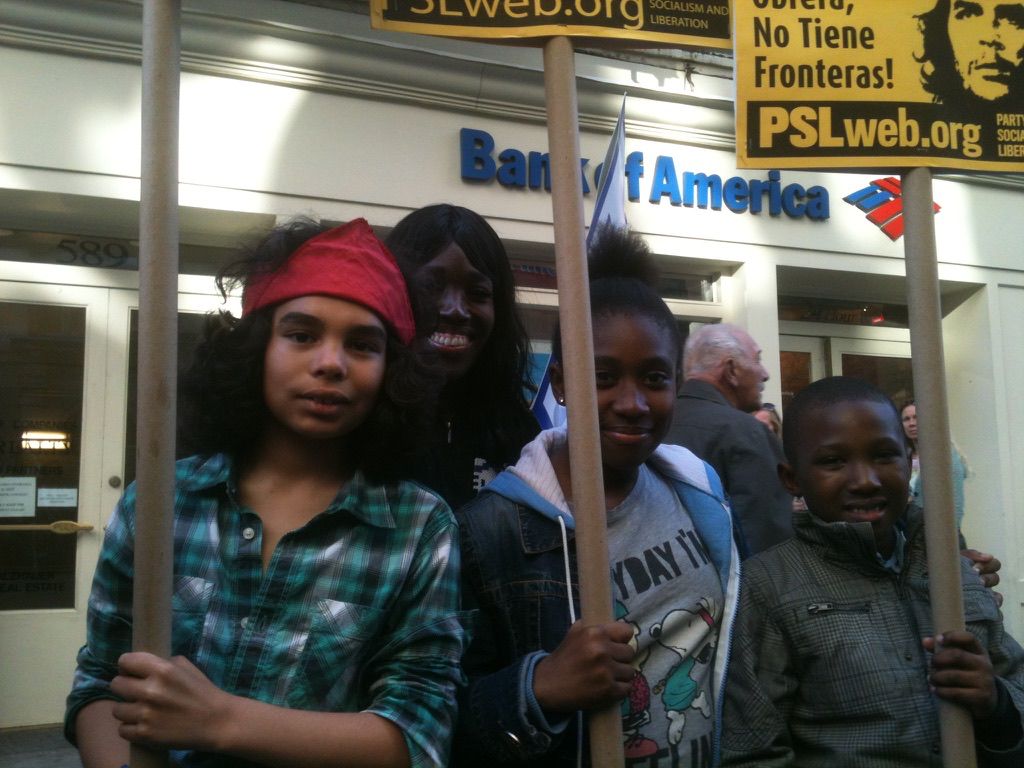
I never read a book on parenting. I never reflected on any of this until I got completely sober. Like no starches and no dating sober. (What percent of America is completely sober?) I made my share of mistakes for which I’ve made amends. I raised my oldest son instinctually the way I lived every day of my life. My class instincts are his. His class reflexes are mine.
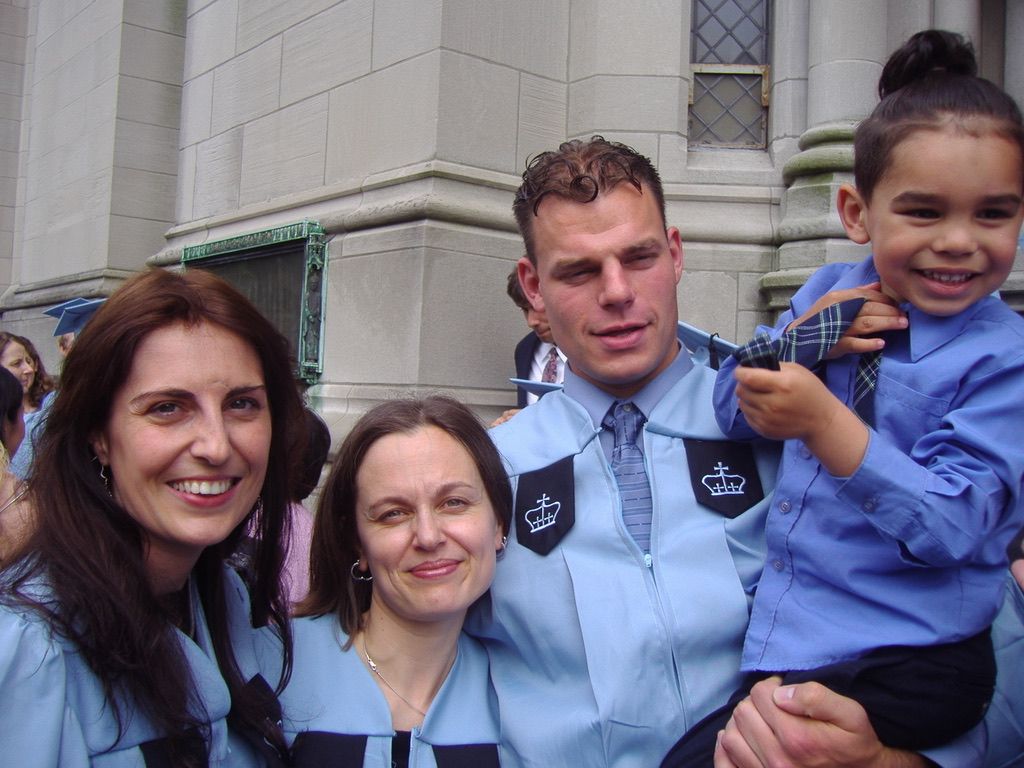
From the streets of Santo Domingo and Brockton to the streets of Paris and Kuala Lumpur, my son taught me how to be a man. In the process, I exposed him to the infinite beauty of this vast, open road we know as life. Bob Marley raised this very question in “Rebel Music 3 o’clock roadblock:” “Why can’t we roam? There’s open country. Oh Why can’t we be what we want to be? We want to be free.” I modeled being a natural-born ethnographer to my son and he revealed this to me in words I’d never heard.
Venezuelan revolutionary assassinated
Originally published at Liberation News on October 5, 2014.
The people of Venezuela and the world are in mourning over the murder of the Bolivarian leader Robert Serra and his companion Maria Herrera on Oct. 1 in their home in Caracas. Robert Serra — the youngest elected representative to the National Assembly and leader of the youth wing of the United Socialist Party of Venezuela (PSUV) — was an important figure and inspiration within the Bolivarian revolution. Known for his humility and warmth, Serra was a tireless worker in the fight for a self-determining, socialist Venezuela.
While the authorities are still conducting a full investigation there is ample evidence that exposes the role Colombian paramilitaries played in his assassination. Minister of Interior Relations Miguel Rodríguez Torres stated:
“We are not dealing with unfortunate events committed by a common criminal. We are dealing with an intentional murder, planned and executed with great precision. According to the evidence obtained everything points to a planned, organized and detailed assassination technique.”
In a recently released video, right-wing Venezuelan spokesperson Lorent Saleh highlighted his links to former Colombian president and death squad organizer Álváro Uribe, and the acquisition of over $8,000 of weapons to be used for a “social cleansing,” apparently referring to his political opponents in the Chavista (supporters of deceased president Hugo Chávez’s revolution) camp. He outlined plans to target 20 “dirigentes” for execution including the young, charismatic Chavista leader Robert Serra.
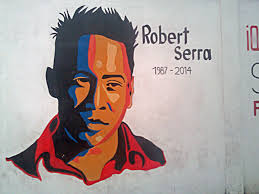
Why would the conscious people of the world think for a second that a ruling class still desperately grasping to maintain power is not capable of this vile, heinous crime against the collective interests of Venezuela’s working class? These are the very same political forces who orchestrated a bloody coup against the democratically-elected president Hugo Chávez in 2002, killing 53 people in the process. Later that same year the bosses of the Venezuelan oil company PDVSA engineered an oil shutdown in an attempt to bring Venezuela’s economy to its knees. Today the owning class hoards essential items like flour, food and household goods to create economic havoc for the masses of Venezuelans. In concert with the international finance system, they have intentionally sparked inflation and devalued the national currency. Most recently the right wing has organized violent mobs in an attempt to create more chaos and spark a civil insurrection against the government of President Nicolás Maduro. This is their latest calculated and cold-blooded attempt to demoralize the honest, freedom-loving patriotic forces.
Flipping reality on its head the bourgeois press here and in Venezuela has gone to great lengths to present the government as the instigators of the violence. We must be clear about who the true terrorists are in Venezuela. Malcolm X’s words are all too relevant to the challenges the Venezuelan people are facing:
“If you’re not careful, the newspapers will have you hating the people who are being oppressed, and loving the people who are doing the oppressing.”
Serra’s comrades remember how in 2007 at the height of the right-wing student opposition movement he came to their campus proposing to debate them publicly in order to highlight their anti-national and opportunist motives. Yon Goicochea — a leader of the privileged students of the private universities — was nowhere to be found, fleeing the university rather than debate the Bolivarian student leader. Robert presented the hostile students with a Venezuelan flag urging them not to stain the symbol of national unity with their narrow, sectarian motives.
Tens of thousands of people across Caracas and Venezuela have come into the streets vowing to continue Robert’s work and to prosecute the material and intellectual authors of his death. President Nicolas Maduro — visibly choked up by the revolution’s loss — vowed to take “swift action against these terrorist acts.”
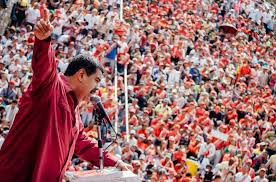
In a statement paying homage to Robert Serra’s life and example the youth of the PSUV declared:
“We assume the responsibility of making the ideals of our comrade reality. He was a fierce defender of his homeland and an unyielding revolutionary who worked to defend the legacy of our eternal commander Hugo Chávez. He will live forever in our hearts and in the principles of our youth.”
We echoe this tribute and pledge to defend the right of the Venezuelan people to freely determine their future without foreign interference. In the words of the revolutionary Chilean poet Pablo Neruda, himself a victim of a U.S.-sponsored coup against his homeland:
“They can pull up all the flowers but they cannot detain the arrival of spring.”
Robert Serra Presente!

